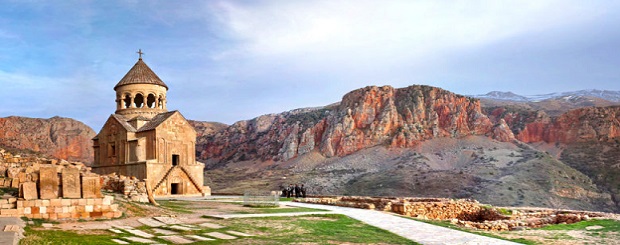
BBC Travel: Symbols and legends of the world’s first Christian state
Sunday, December 8 2019
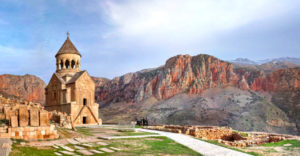
Symbols and legends of the world’s first Christian state:
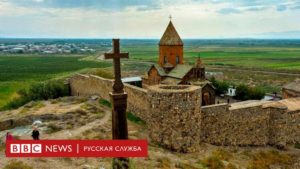
BBC Travel January 06,2018 21:20 15 Russian Air Force service today, January 6, when the followers of the Armenian Apostolic Church celebrate Christmas and the Epiphany, published an article on Armenia in Russian translation
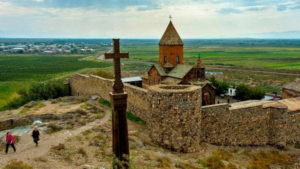
under the heading “Symbols and Legends of the First-ever Christian State” by Amanda Proensa Santos (BBC Travel). We represent without abbreviations: This country proclaimed Christianity as its state religion in the 1st century – in 301 AD. The Armenian Apostolic Church is one of the oldest Christian churches, which differs from both Byzantine Orthodoxy and Roman Catholicism. Christmas is celebrated here on January 6th. Living Christian History Armenia is a small country in Transcaucasia. Its modern population is about 3 million people.
But the role of Armenia in the spiritual history of the world can hardly be overestimated: most historians agree that in 301 AD it became the first Christian state in the world (although there is a point of view that this happened a little later – between 301 and 314 – Note translator). The founders of their church in Armenia are considered the holy apostles Thaddeus and Bartholomew (who preached here and were martyred here).
Today, about 95% of Armenians are Christians, and the religious history of the country lives in its ancient monuments. Spiritual leader According to legend, the first patriarch (Catholicos) of the Armenian Apostolic Church was St. Gregory the Illuminator, who converted to Christianity the Armenian king Trdat III, who made Christianity the state religion after that.
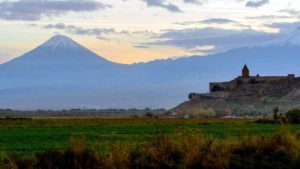
Gregory the Illuminator was the son of the Parthian Anak, who killed the Armenian king Khosrov and was executed for this. The whole family was exterminated, but the youngest son, Gregory, managed to escape. In Caesarea, the Cappadocian boy was baptized and received a Christian upbringing. It so happened that as an adult, Gregory went to Rome and entered the service of Khosrov’s son, Tiridat (later – Trdat III), hoping to make amends for his father.
In 287, with the help of the Roman legions, Tradat regained his father’s throne in Armenia, and Gregory – for professing Christianity – ordered to be thrown into prison, where he spent 13 years in prison, refusing to renounce faith in Christ. This continued until Trdat fell ill (they say he fell into insanity), but, as the legend says, he was healed by Gregory. After that, the king was baptized and proclaimed Christianity the state religion in Armenia. Traces of the distant past The ancient fortress of Garni is located 28 km from Yerevan in the Azat river valley, near the village of Garni. It was built in pagan times, in the 1st century A.D.
king Trdat I, and originally the temple of Garni was dedicated to the sun god. When Christianity became the state religion, many pagan temples were destroyed, but Garni survived, although it was rebuilt by Trdat III. Today it is one of the most popular attractions in Armenia; the historical complex in Garni is visited by more than 136 thousand tourists a year. Church of the Holy Mother Superior To the west of the capital of Yerevan lies Vagharshapat – one of the most significant cultural and religious centers of the country, its spiritual capital.
Here is the Echmiadzin Monastery, the seat of the throne of the Supreme Patriarch Catholicos of All Armenians. St. Guyana Temple (pictured) was built in 630 and is now on the UNESCO World Heritage List. The church was erected on the site of the martyrdom of Mother Superior Gayane. All the same Trdat III killed her – even before he converted to Christianity. The grave of Guyana, proclaimed holy Armenian Apostolic Church, is located here, at the base of the temple. In the temple is the necropolis of the highest Armenian clergy.
Former underground dungeon Khor Virap (in Armenian “deep dungeon”) is a monastery located at the foot of Mount Ararat, near the border with Turkey. It was here that Trdat III kept in prison Gregory the Illuminator. Khor Virap Chapel was built in 642 over an underground prison, where Gregory was once imprisoned. Subsequently, in 1662, in memory of the saint, a large-sized chapel of St. George was added and a monastery was built.
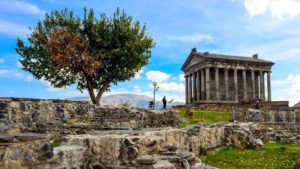
Now Khor Virap is a very popular place for those who want to get baptized or get married. Spear Monastery To the north-east of Garni, in the gorge of the mountain river Gokht, is the Geghard monastery complex, also included in the UNESCO World Heritage List. It was founded in the 4th century on the site of a sacred spring originating in a cave, and therefore it was first called Ayrivank, a “cave monastery”. According to legend, the founder of the monastery was St. Gregory the Illuminator. Of the early structures, almost nothing has been preserved, since in the IX century the monastery was destroyed by the Arabs, and in the XIII century it was rebuilt again.
The current name of the Geghard monastery means “spear” in Armenian. This refers to the Longinus spear with which the Roman warrior pierced the body of Jesus Christ on the cross – it is alleged that the spear was brought to Armenia by the Apostle Thaddeus (now it is exhibited in the Museum of Etchmiadzin, and earlier, for 500 years, it was kept in the Geghard monastery). Temple for Warriors The Church of Surb Zorats (“Holy Army”) in the village of Yeghegis in the Vayots Dzor region was built at the beginning of the XIV century, when the country was ruled by the Mongols and was at war with the Syrian Mamelukes.
It is unique in that it does not have a hall for worshipers, it is replaced by a large outdoor area. It is believed that the church was built in this way for the troops stationed there during the service. The altar is located at the level of the rider in the saddle – so that the soldiers could not leave their horses, and immediately after the service, the blessed ones went to battle. The symbol of soul salvation Khachkara (stone steles with a carved image of the cross) was considered a symbol of soul salvation – both the living and the dead. On the territory of Armenia there are several thousand cross-stones, each with its own unique pattern. It is believed that they began to be built around the 9th century – often on the site of former pagan temples, as a sign of a new faith. Today, the art of creating khachkars (“Symbols and craftsmanship of khachkars, Armenian stone crosses”) is included in the representative list of UNESCO on the intangible cultural heritage of humanity.
The largest khachkar cemetery in the territory of modern Armenia (and the largest in the world) (pictured) is in the ancient village of Noratus: there are more than 800 here. Most of the khachkars here date from the 13th – 17th centuries, and the oldest – to the 5th century. Brother Stonehenge? The ancient megalithic complex Karahunge, located on a mountain plateau at an altitude of 1770 meters above sea level in the Syunik region of Armenia, can be compared both in age and in appearance with Stonehenge. The historical and cultural reserve is spread over an area of about 7 hectares and consists of tombs, a central ring with a diameter of up to 45 m and rows of megaliths, large standing stones, about a third of which have round holes in their upper part. Regarding the age of the structure, estimates differ.
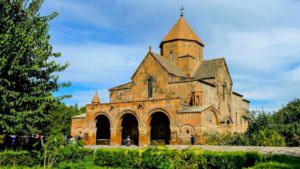
Some experts say that he can be about 7 thousand years old. The construction consists of 223 basalt stones 1.5–2.8 m high and weighing up to 8.5 tons. Historians are inclined to believe that Karahunj served prehistoric people as a burial place. Some scientists believe that the complex is the oldest observatory in the world, but there is no solid evidence for this. Most likely, in different periods of its existence it was used in different ways – from a cattle pen to a cemetery.
All photos – Air Force
ORIGINE SOURCES-nashaarmenia.info/2019/12/08/bbc-travelсимволы-и-легенды-первого-в-мире-хри-3/
ENGLISH TRANSLATION “lousavor avedis“
